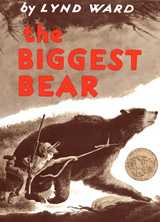The Biggest Bear
 | |
| Author | Lynd Ward |
|---|---|
| Illustrator | Lynd Ward |
| Country | United States |
| Genre | Children's picture book |
| Publisher | Houghton |
Publication date | 1952 |
| ISBN | 0-395-14806-5 |
| OCLC | 225482 |
| [E] 19 | |
| LC Class | PZ7.W2146 Bi 1988 |
The Biggest Bear is a children's picture book by Lynd Ward, first published in 1952. It was illustrated using opaque watercolors, and won the prestigious Caldecott Medal for illustration in 1953.[1]
Johnny Orchard, a young boy, is jealous because his neighbors have bear pelts hanging on their barns, so he takes a rifle and goes hunting for the biggest bear in the valley. However, when he finds only a bear cub, he befriends it by feeding it maple sugar and brings the bear home as a pet. As it grows, it becomes a nuisance to his family and the neighbors due to its enormous appetite. After the neighbors complain to his father, Johnny tries three times to return the bear to the woods. Each time the bear follows Johnny back home. Finally Johnny and his father decide the only way to solve the problem is to shoot the bear. Johnny takes the bear far into the woods, but while loading his rifle, the bear runs off and into a live trap that has maple sugar in it. Men who had set the trap to capture animals for the zoo soon come. They take Johnny's bear to a zoo where Johnny can visit him anytime.
Freudian analysis of this book
In the Pulitzer Prize-winning The Denial of Death, Ernest Becker cited The Biggest Bear as an example of how the innate human fear can become manifested in literature.[2]
References
- ↑ American Library Association: Caldecott Medal Winners, 1938 - Present. URL accessed 27 May 2009.
- ↑ Ernest Becker: The Denial of Death, 1973
| Awards | ||
|---|---|---|
| Preceded by Finders Keepers |
Caldecott Medal recipient 1953 |
Succeeded by Madeline's Rescue |